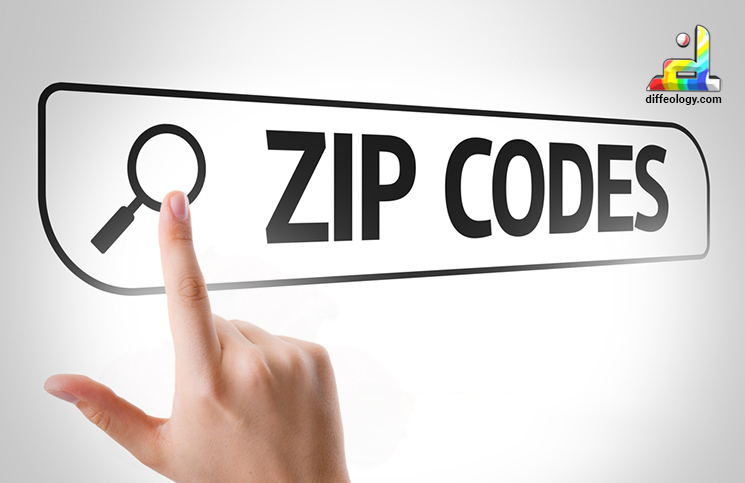Navigating the world of mail delivery often involves understanding the codes that play a crucial role in sorting and delivering packages to our doorsteps. In this area, there are two common terms – Zip Code and Postal Code. They may be similar sounding, but there is a huge difference between Zip Code and Postal Code. Both of them are used in separate parts of the world. So what exactly are the differences between Zip Codes and Postal Codes? In this blog, we will answer these questions. If you’re mailing a letter in the United States, or an international package anytime soon, being familiar with these codes means knowing where to drop letters and which ZIP code is yours.
The Main Difference between Zip Code and Postal Code
Zip Code is Specific to the United States and its territories. Postal Code is Used internationally, with different countries having their own systems. Zip Code is An acronym for Zone Improvement Plan. Postal Code is A generic term used worldwide. Zip Code is Typically five numerical digits (ZIP+4 for more precision). Postal Code is Varies globally, using combinations of letters and/or numbers.
Zip Code Vs. Postal Code
What is a Zip Code?
The Zip Code, also known as “Zone Improvement Plan Code,” is a series of numbers or letters applied to any geographical area in the United States. The United States Postal Service (USPS) adopted these codes in 1963 to streamline mail delivery. For the postman, each Zip Code makes it easier and more accurate to determine where a piece of mail is going.Decode mailing nuances! Learn the difference between Zip Code and Postal Code with Diffeology.com. Streamline your address knowledge now!
Read Also: Difference Between Nationality and Citizenship
The Zip Code system divides the country into regions, states, and cities; within a city or state, each neighborhood is assigned its own unique code. The correct Zip Code always seals the delivery of letters and packages. The first digit of the Zip Code indicates a large area, and as you go further through the digits it becomes more refined until finally it describes precisely your location. The postal system incorporates Zip Codes in order to simplify sorting and delivery of thousands upon thousands of letters every day.
What is a Postal Code?
More commonly known as a postcode, this string of numbers or letters assigned to an area is designed to assist in the sorting and delivering of mail. Around the world, postal services use Postal Codes to organize and simplify the delivery of letters and packages. Like Zip Codes in the United States, Postal codes help postmen locate where mail should be delivered much more easily.
Read Also: Difference Between Race and Ethnicity
Every country has its own set of Postal Codes and within a single nation, different areas, cities, or neighborhoods may have their individual codes. In other words, if you add the right Postal Code to your mail then the post office will be able to route it and deliver it accurately. In the modern postal system, Postal Codes play a vital role in helping to automate sorting and speed up delivery.
Comparison Table “Zip Code Vs. Postal Code”
| Geographic Applicability | Specific to the United States and territories | Used internationally, each country has its own system |
| Naming Conventions | Acronym for Zone Improvement Plan | Generic term used globally |
| Format and Structure | Typically five numerical digits (ZIP+4 for precision) | Varies globally, alphanumeric combinations |
| Origins and Development | Introduced in 1963 by USPS | The concept predates zip codes, starting in 1932 |
| International Usage | Not used in international mail; other countries have their own systems | Essential for global mail delivery, unique to each country |
| Role in Mail Sorting | Crucial for sorting U.S. mail efficiently | Facilitates global mail sorting, enhancing accuracy and efficiency |
| Examples from Different Countries | Examples like 90210 (Beverly Hills) and 10001 (New York City) | Examples include M5H 2N2 (Toronto, Canada) and SW1A 1AA (London, UK) |
| Length and Composition | Generally five digits (optional extra four for precision) | Varies in length and composition globally |
| Geographic Scope | Exclusive to U.S. and territories | Used globally, each country with own system |
| Terminology | Specific to the United States | Internationally recognized term |
| Recognition in Different Countries | Limited to U.S. mail; not recognized abroad | Recognized and used globally for international mail |
Difference Between Zip Code and Postal Code In Detail
Definition and Usage:
A zip code (which stands for Zone Improvement Plan code) is a postal or area code used in the United States. Zip codes were developed by the United States Postal Service (USPS) in 1963 to allow for precise geographic zone assignment. A common format for zip codes is five digits, with four additional ones added on optionally to define location even more precisely. Zip codes are designed mainly to help handle domestic mail in the United States.
A postal code is a set of letters, numbers, or some combination thereof used to designate a particular geographical area when sorting and delivering mail. This is an international term, and different countries have their postal code systems. Other countries, such as Canada, use postal codes. The United States uses zip codes. The principle of postal codes is to facilitate mail delivery by identifying each area or locale within a country with its unique identifier.
Geographic Scope:
Zip codes apply only to the United States and its territories. They are not standard in international use, and these stamps only apply to the USPS system. One zip code represents one area in the United States, such as a city; town, or neighborhood.
Global postal codes, Different countries’ systems for assigning postal codes. For instance, Canada employs alphanumeric postal codes and the United Kingdom uses a mix of letters and numbers for its own. The format and structure of postal codes are different from one country to the next.
Format and Structure:
A zip code (or postcode) in the United States has five digits. A full version, abbreviated as the ZIP+4 code, has another four digits following a hyphen. Generally, the first five digits serve a larger region than the extra four.
There are great differences in the format and structure of postal codes from country to country. In some countries, only numbers are used, and in others letters as well. The length of postal codes also varies, with some having just a few characters and others longer.
Origins and History:
In 1963 the United States established a zip code system to streamline mail delivery. The USPS conceived it to standardize the process of sorting and delivery by establishing a ZIP code system.
The idea of postal codes goes back to the beginning of the zip code. In 1932, Ukraine became the first country to introduce a postal code system, and this idea gradually spread. Over the years, different countries developed their versions of postal codes.
Naming Conventions:
The term zip code derives from the Zone Improvement Plan, which is unique to the United States. In this way, it has become the standard term for postal codes in the country.
The international generic term for the system of codes used to organize and deliver mail is postal code. It is the better-known term outside of America.
International Recognition:
Zip codes are common and familiar in the United States, but few abroad recognize them. The postal code system used when sending mail overseas varies from country to country.
Global standard Postal codes are used and recognized in countries around the world, making mail sorting and delivery particularly efficient. They are an integral part of systems for international addressing. It is they that ensure the prompt and accurate delivery of mail between nations.
Geographic Applicability:
Zip code is unique to the United States and its territories. It is used only within the U.S. postal system and has no international application whatsoever. It is because mail within the United States is delivered according to zip codes, these are essential parts of modern life.
On the other hand, postal code is a more general term that designates mail delivery areas and is used throughout the world. Countries have different postal code systems. They are, for example, Canada’s alphanumeric postcodes and the UK’s alphanumeric codes. International mail is not exempt from postal codes.
Naming Conventions:
The zip code is actually an acronym for Zone Improvement Plan, reflecting both its origin and purpose. In 1963, it was adopted in the United States to make mail sorting more efficient by assigning a unique numerical code for each area.
The term “postal code” is a generic one that covers the wider concept of mail codes used all over the world. It is a neutral term used in each country according to its own particular system of organizing and identifying postal regions.
Format and Structure:
Zip codes in the US are basically five digits of numbers. Known as the ZIP+4 code, it is an extended version including four extra digits separated by a hyphen. The first five digits determine a general geographic location, and the rest are for more exact address information.
Postal codes are internationally variable in format and structure. In some countries, telephone numbers are represented in the form of only numerical digits; others use a combination of letters and numbers. Since each postal system has its own peculiarities, the length and composition of postcodes also vary from country to country.
Origins and Development:
In 1963, the USPS implemented a zip code system in the U.S. Its main objective was to speed up the handling and distribution of mail inside the country.
In fact, the idea of postal codes came before zip codes. The first postal code system was introduced in Ukraine back in 1932 and gradually caught on elsewhere. To make mail delivery more accurate, countries around the world came up with their own systems of postal codes.
International Usage:
International mail does not use zip codes. In mailing abroad, other nations require the use of their own postal code systems. Zip codes are still unique to the United States.
Everyone knows postal codes, and they are indispensable to the proper delivery of international mail. Knowing the proper postal code and including it with mail destined for various nations helps make sure your letters get to where they’re going quickly and precisely.
Role in Mail Sorting:
Inside the United States, zip codes act to automate sorting and delivery of mail. It helps the postal services quickly locate where a piece of mail is going, making processing more efficient.
In a similar vein, the postal codes used in sorting mail around the world are essential. They allow postmen and sorting machines to classify mail so that it can be routed to the right geographic area – streamlining everything.
Examples from Different Countries:
For example, 90210 is Beverly Hills (California), while 10036 is New York City. These numerical codes effectively serve to identify particular regions within the United States.
International postal codes include M5H 2N2 (Toronto, Canada) and SW1A 1AA (London, UK). These codes, which combine letters and numbers, help pinpoint exact locations in all countries.
Key Points Showing Difference between Zip Code and Postal Code
- Origins and Development: Zip Code was Introduced in 1963 by the United States Postal Service (USPS). The Postal Code Concept predates zip codes, with the first system in Ukraine in 1932.
- International Usage: Zip Code is Not used in international mail; other countries have their systems.
- Postal Code is Essential for international mail delivery, unique to each country.
- Role in Mail Sorting: Zip Code is Crucial for sorting and delivering mail efficiently within the U.S. Postal Code Facilitates global mail sorting, aiding accuracy and efficiency.
- Examples from Different Countries: Zip Code Examples include 90210 (Beverly Hills) and 10001 (New York City). Postal Code Examples include M5H 2N2 (Toronto, Canada) and SW1A 1AA (London, UK).
- Length and Composition: Zip Code is Generally five digits (optional extra four for precision). Postal Code is Varies in length and composition worldwide.
- Geographic Scope: Zip Code is Exclusive to the U.S. and its territories. Postal Code is Used globally, each country with its own system.
- Terminology: Zip Code is Specifically used in the United States. Postal Code is A term recognized and used internationally.
- Recognition in Different Countries: Zip Code is Limited to U.S. mail; not recognized abroad. Postal Code is Recognized and used globally for international mail.
- Standardization: Zip Code is a Standardized system within the U.S. postal service. Postal Code is a Standardized system that varies between countries.
- Government Agency Involvement: Zip Code is Administered by the United States Postal Service (USPS). Postal Code is Administered by various national postal services globally.
- Historical Introduction: Zip Code was Introduced in 1963 as a response to the need for mail efficiency. The Postal Code originated in the early 20th century with gradual global adoption.
FAQs: Zip Code Vs. Postal Code
Conclusion:
Though the lines of communication are increasingly stretched in today’s global village, you can never understand too much about how mail is delivered. Now that we have examined the Difference between Zip Code and Postal Code, it’s clear these seemingly trivial codes are indispensable in making postal services run smoothly. Whether you are dealing with the Zip Code system used by the United States, or other Postal Codes that vary from one country to another, being aware of these differences gives you mastery over your mail environment. So the next time you mail a letter or package, think of these codes. You’ll make sure your missive takes Swiftlink to its destination-no matter where in this sin-categorized world it may be.



